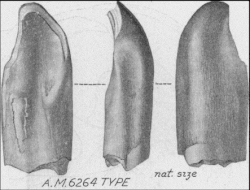| Asiatosaurus Temporal range: Early Cretaceous, | |
|---|---|
 | |
| Holotype tooth of A. mongoliensis (AMNH 6264) seen from three different angles | |
| Scientific classification | |
| Domain: | Eukaryota |
| Kingdom: | Animalia |
| Phylum: | Chordata |
| Clade: | Dinosauria |
| Clade: | Saurischia |
| Clade: | † Sauropodomorpha |
| Clade: | † Sauropoda |
| Genus: | † Asiatosaurus Osborn, 1924 |
| Type species | |
| †Asiatosaurus mongoliensis Osborn, 1924 | |
| Other species | |
| |
| Synonyms | |
| |
Asiatosaurus (meaning "Asian lizard") is an extinct genus of herbivorous sauropod dinosaur which lived during the Early Cretaceous in Mongolia and China. [1] The type species is known only from teeth, making it difficult to rely on information until more specimens are found to expand our knowledge, and another species is known, also based on scant remains; both are now classified as nomina dubia .











